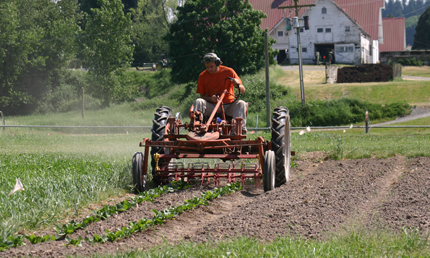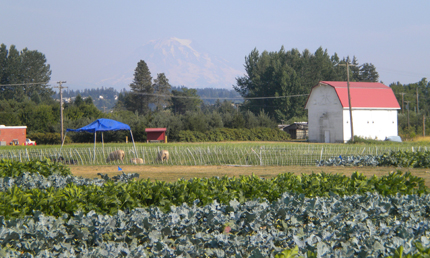Soil Science Society of America
5585 Guilford Road • Madison, WI 53711-5801 • 608-273-8080 • Fax 608-273-2021
www.soils.org
Twitter | Facebook
NEWS RELEASE
Contact: Hanna Jeske, Associate Director of Marketing and Brand Strategy, 608-268-3972, hjeske@sciencesocieties.org
Organic panic: finding the right combination
Sept. 14, 2016 - Organic vegetables are popular. However, growing them is notoriously high-maintenance for farmers. Researchers are trying to identify the best ways to grow these crops in order to keep the shelves stocked.
 Growing organic vegetables is labor intensive, says Craig Cogger. Cogger is a researcher for the Department of Crop and Soil Sciences at Washington State University. “Weed management, amendment choice, and cover crop management are particularly challenging when growing vegetables in an organic system,” he explains.
Growing organic vegetables is labor intensive, says Craig Cogger. Cogger is a researcher for the Department of Crop and Soil Sciences at Washington State University. “Weed management, amendment choice, and cover crop management are particularly challenging when growing vegetables in an organic system,” he explains.
Farmers have been using a mix-and-match approach to practices for growing their organic veggies. Which combination of practices was best, however, was uncertain.
Cogger and colleagues studied twelve different combinations of practices over the course of ten years to see what worked best. Their study included three types of cropping systems. One system planted a fall cover crop, another used a relay-planted cover crop, and the third system was a short-term grazed pasture. Two types of amendments were included in the study. Amendments are additions of organic materials to the soil to improve the soil’s condition. One amendment was a compost mixture of dairy manure, straw, sawdust, and yard debris. The other amendment was a mixture of sawdust and manure from a local poultry producer. Finally, two methods of tilling the soil were used in the study. The researchers tilled with a plow and also with a rotary spader.
But let’s not forget the veggies! Cogger and his team used these twelve combinations to grow broccoli, lettuce, winter squash, spinach, snap bean, and winter wheat. Over ten years, the researchers harvested the crops to determine crop yields. They also measured the soil’s physical properties.
 After studying the samples and analyzing the data, Cogger and his team found that no one factor consistently increased the amount of vegetables produced. But they did discover the mixed compost improved the soil’s physical properties more than the sawdust and poultry litter. They also found benefits from tilling with the rotary spader. “We could often prepare the field in a single pass, and we occasionally had increased yields,” says Cogger.
After studying the samples and analyzing the data, Cogger and his team found that no one factor consistently increased the amount of vegetables produced. But they did discover the mixed compost improved the soil’s physical properties more than the sawdust and poultry litter. They also found benefits from tilling with the rotary spader. “We could often prepare the field in a single pass, and we occasionally had increased yields,” says Cogger.
Overall, the changes in the soil were short-term. “Most of the differences among systems evolved in the early years of the experiment,” Cogger notes. “The overall results may not be too different from a shorter experiment, but the longer-term study helps our understanding of the evolution of organic systems,” Cogger explains.
The results also showed minimal interactions between management practices. This means farmers can continue to mix-and-match their practices depending on their individual situations. This may include cost considerations as well as soil conditions, Cogger says. “The compost amendment would be expensive for many farmers, and the rotary spader is a relatively large up-front investment. But if farmers can afford it, the rotary spader can save time, improve soil compaction and seed bed quality, and sometimes improve yields.”
Read more about Cogger’s research in Agronomy Journal. USDA Integrated Organic Program and Western Region Sustainable Agriculture Research and Education funded the research.
Agronomy Journal is the flagship journal of the American Society of Agronomy. Articles convey original research in agriculture, natural resources, soil science, crop science, agroclimatology, agronomic modeling, production agriculture, and instrumentation.